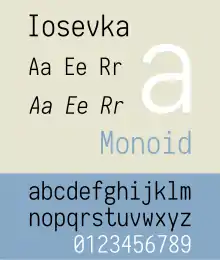Iosevka
Iosevka (IPA: [ˌjɔˈseβ.kʰa])[2] is a monospace programming typeface, built declaratively using custom typeface generation software, and with an emphasis on compatibility with CJK characters.[3] It is available under a FOSS license. The default builds are available in two styles of seven weights each, and come with italic and oblique versions. The typeface was designed, however, to be easily configurable by editing textual TOML configuration files in the custom generation software.
 | |
| Category | Monospaced font family |
|---|---|
| Classification | Monospaced font Sans serif Slab serif Unicode font |
| Designer(s) | Belleve Invis |
| Date created | 2015 |
| Date released | 19 Jul 2015 |
| License | SIL Open Font License |
| Design based on | PragmataPro, PF DIN Mono, M+ |
| Website | typeof |
| Latest release version | 4.3.0 (2 January 2021)[1] |
The character repertoire covers a significant portion of the Basic Multilingual Plane of Unicode, and a few characters from the Enclosed Alphanumeric Supplement block.
History
The first version of Iosevka, then named codexHW, was created on 19 Jul 2015,[4] and renamed to Iosevka three days later.[5] It is the product of Chinese typographer Renzhi Li, using the Romanised pseudonym Belleve Invis.[6]
Features
Iosevka is a condensed font, with double width CJK characters, using a slashed zero by default. It contains many ligatures, especially suited towards functional programming languages such as Coq, Idris, and Haskell. The variant Iosevka Term is designed to better support terminals and the variant Iosevka Fixed omits the ligatures. It also comes with OpenType features including stylistic sets and character variants.
Build process
One major characteristic of Iosevka is that it is generated from declarative data files using a multi-phase build process.[7] It was originally created as a typeface that could be used with a package called node-sfnt:
As I maintaining node-sfnt [sic], a low-level library used to parse and generate TTFs in Node.JS, I decided to make a programming font using it. Iosevka is generated from a program written by me, as well as a set of parameters, pretty like Computer Modern, but in a more modern way. [...] [C]reating a font actually needs a domain-specific language, like Knuth's METAFONT language. With PatEL's macro system I can easily turn PatEL into a DSL while remaining its full ability of programming. The PatEL is in another repository I created, though not documented yet. It's syntax is basically a Lisp with improvements reducing brackets (by using colons and indents), and supporting infix operators.[8]
As of 2018 the data files are still written in the Patrisika Example Language, also known as PatEL.[9] PatEL is an alternative s-expression format somewhat akin to the wisp of SRFI 119.[10] The PatEL data is then converted into SpiderMonkey AST using another library called Patrisika.[11] The AST is then converted into JavaScript using Escodegen.[12]
References
- "Release 4.3.0". 2 January 2021. Retrieved 8 January 2021.
- How to pronounce "Iosevka"?
- "Because I and many of my friends live in China and Japan, I decided to make my font exactly half-width, to be compatible with Han Characters (exactly 1em wide)." — A programming typeface
"Do you know that all letters in Iosevka are EXACTLY 1/2 em wide? For ASIAN users, you can use THIS and preserve your perfect alignment." — be5invis - Created in commit 075cd395d1457e69
- The name was changed in commit 3326d7ab3704fd29
- typeof.net
- Comment by the author
- A programming typeface
- PatEL
- SRFI 119
- Patrisika
- Escodegen
External links
- Iosevka official releases, github.com
- Discussion on Hacker News (2017), news.ycombinator.com
- Discussion on Reddit (2017), reddit.com
- Iosevka Term package for Arch Linux, aur.archlinux.org
- Review by Luc Devroye, luc.devroye.org